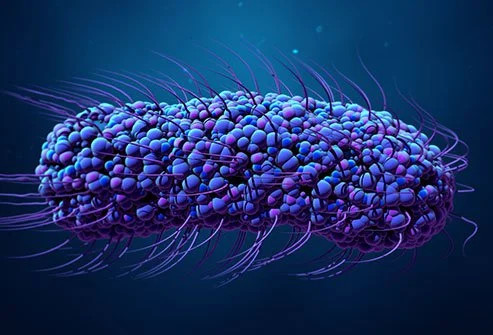Definition
Typhoid fever is an infectious disease caused by the bacteria Salmonella typhi. It is usually transmitted through contaminated food or water, but it can also be passed on from person to person through the saliva of the infected person. Although it can affect anyone at any age, typhoid fever is particularly common among children in developing nations.
The bacteria can disseminate throughout the body and impact multiple abdominal organs, leading to a condition known as abdominal typhoid. This disease may lead to severe consequences that have the potential to cause death. Typhus can be treated and avoided by lowering the risk factors.
Causes
Salmonella typhi is the cause of typhoid fever. This pathogen is transmissible via contaminated food or drink and through direct contact with infected individuals. Inadequate sanitation and contaminated drinking water are the leading causes of typhoid fever. Individuals who have recovered from typhoid fever may still carry this bacteria in their gallbladder or digestive system. Indeed, these germs are capable of being preserved for years. Chronic carriers can infect other individuals even though they no longer exhibit signs and symptoms of typhus. This group of people is referred to as chronic carriers.
Risk factor
The following are risk factors for typhoid fever:
- Poor personal hygiene and unhealthy lifestyle. People in areas with contaminated water supplies and those with poor hand hygiene are at higher risk
- Age. Children are more susceptible to this infection since they are not practising proper personal hygiene.
- History of traveling to endemic areas
- Exposure. People who work in laboratories and come into direct contact with typhoid fever patients are also at higher risk
Symptoms
Typhoid fever symptoms are condition-specific and change as the disease progresses. The following symptoms are:
- Fever. Typhoid infection is characterized by a progressive increase and decrease in body temperature up to 40.5 C (step ladder pattern).
- Headache
- Body weakness (malaise)
- Fatigue
- Dry cough
- Loss of appetite
- Weight loss
- Stomach ache
- Diarrhea or constipation
- A red rash on the skin
If left untreated, typhoid fever may lead to severe symptoms, such as:
- Cognitive impairment characterized by slurred speech and a decreased degree of consciousness
- Severe abdominal pain as a result of a perforation (a tear in an intestinal organ)
- Dark stools may indicate bleeding in the gastrointestinal tract.
- Pale skin and sluggishness as a result of dehydration.
Diagnosis
To confirm the diagnosis, the doctor will perform a comprehensive anamnesis to gather information about:
- Progression of symptoms
- Previous medical history
- Travel history of the last few days
- Possible risk factors
Physical and additional examinations will help confirm the diagnosis, such as:
- Blood test. Blood tests are carried out to look for signs of infection in the body
- Widal test and Tubex test. This test is more specific and is carried out to confirm the presence of bacteria. The Widal test is the most frequently performed examination to diagnose typhoid fever. The examination aims to detect antibodies to the H and O antigens of Salmonella typhi bacteria. A positive result of the Widal examination will indicate suspicion of typhoid if the titer obtained shows a result more than equal to 1/320. The tube test is an examination that detects immunoglobulin M (IgM) antibodies against the O9 antigen from Salmonella typhi bacteria. This tube test is more accurate than the Widal test.
- Culture test. A culture test is a procedure for taking fluid from several parts of the body (aspiration) using a needle. The gold standard of culture tests is bone marrow fluid, but this procedure can cause severe pain. Apart from bone marrow aspiration fluid, cultures can also be made from blood, vomit, or stool samples. One of the drawbacks of this test is that the results take a long time. Therefore, this examination is rarely recommended by doctors.
Management
The management of typhoid fever involves both pharmacological and non-pharmacological interventions, including:
- Antibiotics
Ciprofloxacin is an antibiotic option for treating typhoid fever in non-pregnant adults. Azithromycin is another antibiotic that can be used, and it is typically prescribed in situations where ciprofloxacin cannot be used. Ceftriaxone is another antibiotic that may be prescribed if the disease is more severe. This treatment can be administered at home or in the hospital, depending on the severity of the condition.
- Fluid therapy
Typhoid fever patients need to drink lots of water to avoid dehydration from fever and diarrhea.
- Bed rest
Patients with typhoid fever are advised to avoid intense activities to enhance recovery and prevent complications.
- Consuming easy-to-digest food
People with typhoid fever may have problems with the intestine, which requires consuming easily digestible foods such as porridge. These foods help the body absorb nutrients.
Complications
Untreated typhoid fever may result in severe complications. The following are the most prevalent complications of typhoid fever:
- Bleeding. Bleeding typically occurs within internal organs.
- Gastrointestinal perforation.
- Myocarditis.
- Endocarditis
- Pneumonia
- Pancreatitis
- Bladder and kidney infections
- Meningitis
- Delirium, hallucinations, and paranoid psychosis
Prevention
The following are some of the precautions that can be followed to avoid typhoid fever:
- Maintain sanitation and hand hygiene.
- Administer typhoid immunization every 3 years, particularly in endemic areas
- Wash your hands with clean water and soap, particularly while handling food or after using the toilet.
- Avoid raw foods
- Avoid unhygienic foods
- Avoid contact with infected patients
If you have recently recovered from this illness, you can take the following precautions to prevent the spread of Salmonella typhi:
- Take the medication until it is completed, as directed by your doctor
- Frequent handwashing
- Do not share eating or drinking utensils.
- Prevent preparing meals for others unless instructed otherwise.
When to see a doctor?
See your doctor immediately if you experience typhoid symptoms, as the treatment requires antibiotics, particularly for individuals in endemic areas with poor sanitation.
- dr Ayu Munawaroh, MKK
Mayo Clinic. https://www.mayoclinic.org/diseases-conditions/typhoid-fever/diagnosis-treatment/drc-20378665
NHS. https://www.nhs.uk/conditions/typhoid-fever/
Medline Plus. https://medlineplus.gov/ency/article/001332.htm
Cleveland Clinic. https://my.clevelandclinic.org/health/diseases/17730-typhoid-fever/prevention












